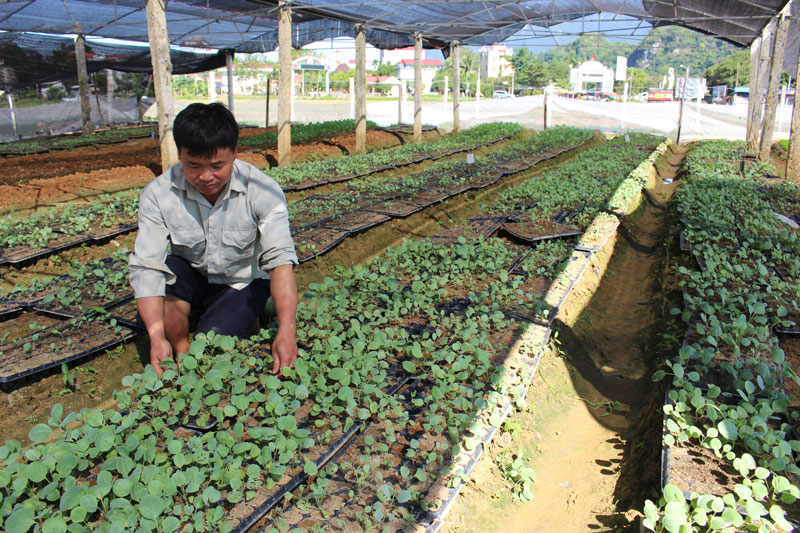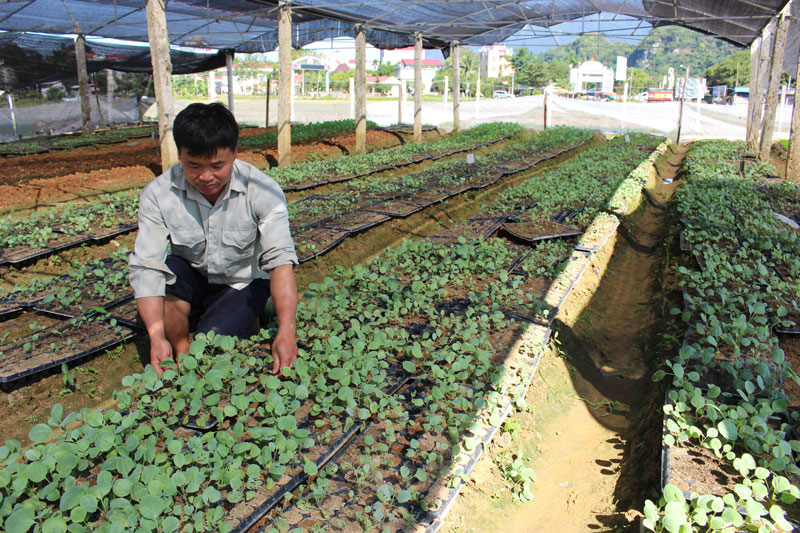
(HBO) – Besides rice and maize fields, Kim Boi district in the northern mountainous province of Hoa Binh has a large vegetable growing area. The district supplies vegetables for consumers around the year. Thanks to convenient traffic system and favourable natural conditions, concentrated vegetable growing areas have been developed in the communes of Vinh Dong, Ha Bi, Nam Thuong, Vinh Tien, and Tu Son.

Ha Bi agricultural cooperative (Kim Boi district) prepares vegetable
seedlings for safe vegetable production.
According to the district’s Division
of Agriculture and Rural Development, Kim Boi now has over
2,500 hectares of
vegetables in 27 communes, producing some 44,500 tonnes. Cucumber, winter melon
and pumpkin account for 44.6 percent of the total area, while leaf vegetables make
up 43.5 percent, and root vegetables, 11.9 percent.
Khuong Minh Trung, head of the agricultural
and forestry encouragement station, said the district has favourable conditions
for vegetable growing, particularly in the communes of Du Sang, Vinh Dong, Ha Bi,
Trung Bi, Kim Boi, Kim Binh and Son Thuy.
However, it is necessary to ensure
safety in producing vegetables in tandem with processing and consumption, in a
bid to enhance the products’ competitiveness, effectively use land and human
resources, and improve incomes for farmers, thus contributing actively to the
local socio-economic development.
According to Trung, the district is developing
high-value and safe vegetable growing areas in line with standards, with
consumption contracts and sustainable production connection.
In 2016, safe vegetable growing areas
were zoned off in 25 out of 27 communes in the district, with a combined area
of
1,522.3 hectares.
Farmers were provided with techniques
to grow safe vegetables. Cooperatives were encouraged to establish specialised
teams while publicity campaigns were conducted to help farmers grow vegetables
in line with the VietGAP standards, raise legal awareness among safe vegetable
growing households and groups, and promote trade exchanges and seek consumption
markets.
In 2017, billions of VND were
invested in developing safe vegetable growing models, as part of the project to
produce safe vegetables from 2016 – 2020. Accordingly, four hectares have been
zoned off for growing safe vegetables in Ha Bi and Sao Bay communes with the
participation of 70 local households. The Ha Bi and Sao Bay cooperatives
together with local farmers have developed product chains.
The district is expected to have
50 hectares of safe
vegetables by 2020, and develop large-scale fields of vegetables, thus
generating much higher value than other crops./.
According to data from the Hoa Binh Provincial Party Committee, the industrial production index for the first six months of 2025 is estimated to have increased by 20% compared to the same period last year. This marks the highest year-on-year growth rate for this period since 2020.
In the first six months of 2025, Hoa Binh province’s export turnover was estimated at 1.145 billion USD, marking an 18.11% increase compared to the same period in 2024. Import turnover was estimated at $ 804 million, a 17.15% increase, which helped the province maintain a positive trade balance.
The lives of the ethnic minority farmers in Tan Lac district have gradually improved thanks to the new directions in agricultural production. This is a testament to the collective strength fostered through the professional associations and groups implemented by various levels of the district’s Farmers’ Union.
With the motto the "product quality comes first,” after nearly one year of establishment and operation, Muong village’s Clean Food Agricultural and Commercial Cooperative, located in Cau Hamlet, Hung Son Commune (Kim Boi district), has launched reputable, high-quality agricultural products to the market that are well-received by consumers. The products such as Muong village’s pork sausage, salt-cured chicken, and salt-cured pork hocks have gradually carved out a place in the market and they are on the path to obtaining the OCOP certification.
In the past, the phrase "bumper harvest, rock-bottom prices" was a familiar refrain for Vietnamese farmers engaged in fragmented, small-scale agriculture. But today, a new spirit is emerging across rural areas of Hoa Binh province - one of collaboration, organisation, and collective economic models that provide a stable foundation for production.
Maintaining growing area codes and packing facility codes in accordance with regulations is a mandatory requirement for agricultural products to be eligible for export. Recently, the Department of Agriculture and Environment of Hoa Binh province has intensified technical supervision of designated farming areas and packing facilities to safeguard the "green passport" that enables its products to access international markets.



